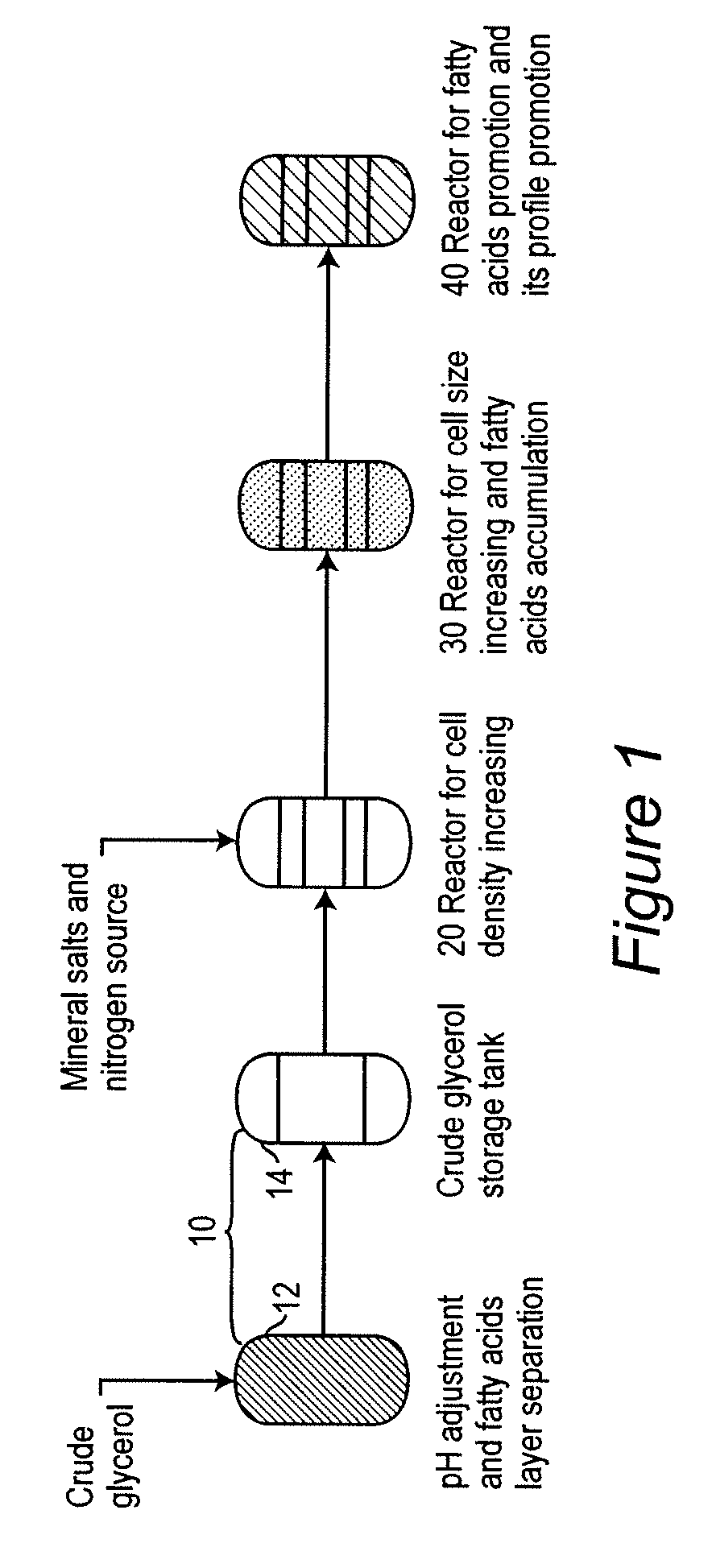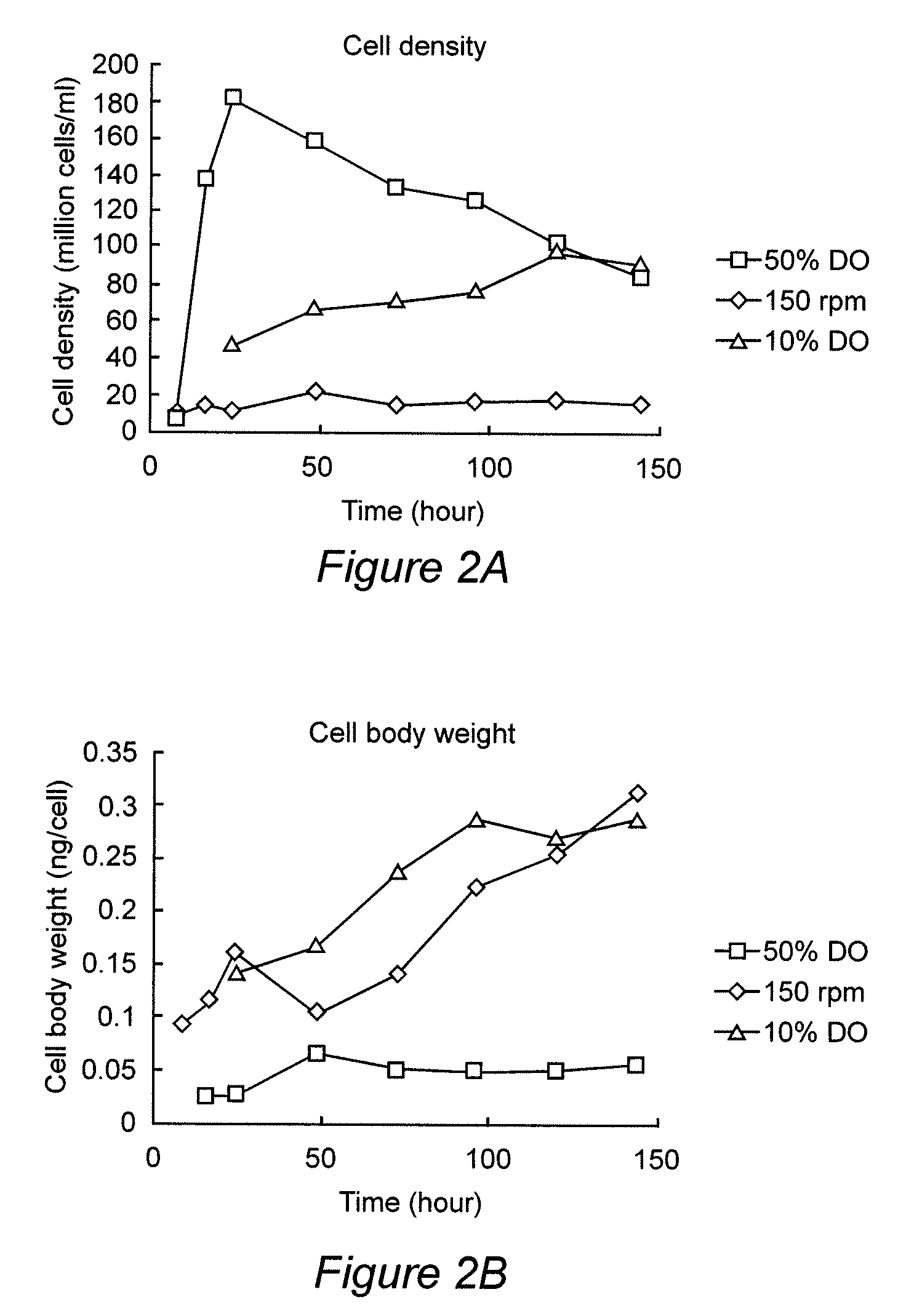Heterotrophic algal high cell density production method and system
a production method and heterotrophic technology, applied in the field of multiphase methods for high density heterotrophic microalgal growth and production of 3 fatty acids, can solve the problems of reducing the cost of algal fermentation, and achieve the effects of increasing cell biomass, increasing lipid content, and increasing the number of cells
- Summary
- Abstract
- Description
- Claims
- Application Information
AI Technical Summary
Benefits of technology
Problems solved by technology
Method used
Image
Examples
example 1
Manipulation of the First Stage Reaction Parameters
[0044]Effective manipulation of the first stage reaction parameters as described herein creates a fermentation condition whereby cell number increases exponentially with only a limited diversion of cellular resources to cell growth. This is illustrated in FIGS. 2A-C and Table 2.
[0045]FIGS. 2A-C show that dissolved oxygen (DO) can be a major control (in concert with alterations in temperature and carbon / nitrogen feeds) in the process. As can be seen, by elevating the DO levels, a process was induced whereby cellular energy and resources were devoted to production of chemicals necessary for cell division, thus allowing for a reaction set-up that greatly increases cell number with little effect on cell size. Conversely, a shift towards lower DO does the opposite, producing an environment in which cellular energy and resources are focused on cellular growth and lipid accumulation.
[0046]The culture controlled 50% DO produced 181 million ...
example 2
[0051]The initial culture medium consists of 40 g / L glycerol, 5 g / L yeast extract and 5 g / L ammonium acetate as the nitrogen source, and other insignificant factors in the salt-water broth. 10% (v / v) of the seed cells from a smaller culture vessel is inoculated to the fermentor. The temperature is controlled at 30° C., and the dissolved oxygen (DO) is controlled at 20% ˜50%. The first stage, or cell number increasing stage, lasts for about 24 hours, in which the cell number increases very quickly with the final cell density being 400˜800 million cells / ml, with the higher the better. When the cell number has stopped increasing, the second stage begins, in which fatty acids are accumulated. The DO is controlled at 3˜5% during this stage with the glycerol and nitrogen concentration controlled at 30˜50 g / L and 0.5˜1.0 g / L by feeding, respectively. The temperature in this stage is still at 30° C., and this stage will last until the 60˜80th hour of the whole process until the dry cell wei...
example 3
Energy Cost Comparison
[0055]Matlab-Simulink software was used to develop an energy cost comparison of the system. Simulation was for a 5-ton fermentor algae process with evaluation based on test data made available from earlier 5 and 30-L experiments.
[0056]Basic assumed parameters for the culture were: 5 cubic meter effective fermentor volume; fed-batch feeding protocol; reaction temperature of 30° C.; average environmental temperature of 25° C,; aeration rate of 0.5 vvm and 1.0 vvm and an electricity cost of $0.046 / kwh. Basic assumed parameters for the heating system were: heat loss being equal to where q is the heat loss, h is the thermal conductivity of the steel, A is the inside area, Ti is the real inside temperature, and T is the outside temperature; heat required is equal to where Q is the heat required, M is the total mass of solution, Cp is the heat capacity, T is the target inside temperature, and Ti is the real inside temperature. Additional assumed parameters for the hea...
PUM
| Property | Measurement | Unit |
|---|---|---|
| Temperature | aaaaa | aaaaa |
| Temperature | aaaaa | aaaaa |
| Temperature | aaaaa | aaaaa |
Abstract
Description
Claims
Application Information
 Login to View More
Login to View More - R&D
- Intellectual Property
- Life Sciences
- Materials
- Tech Scout
- Unparalleled Data Quality
- Higher Quality Content
- 60% Fewer Hallucinations
Browse by: Latest US Patents, China's latest patents, Technical Efficacy Thesaurus, Application Domain, Technology Topic, Popular Technical Reports.
© 2025 PatSnap. All rights reserved.Legal|Privacy policy|Modern Slavery Act Transparency Statement|Sitemap|About US| Contact US: help@patsnap.com



